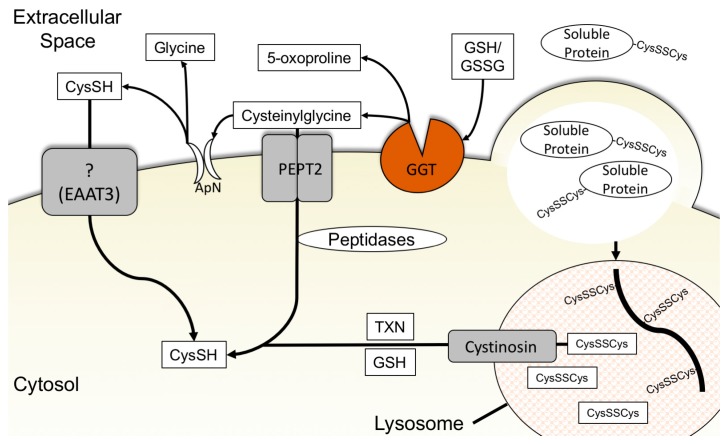Figure 2.
Cells acquire cysteine from extracellular glutathione through the γ-glutamyl cycle, cysteine uptake, and lysosomal protein scavenging by macropinocytosis with cystine export. (Left) Extracellular cysteine is transported into the cell through unidentified cysteine transporters, possibly EAAT3. (Center) The γ-glutamyl bond in extracellular glutathione is cleaved by GGT to create 5-oxoproline and the dipeptide cysteinylglycine. Cysteinylglycine can be taken up by the cell through PEPT2 and cleaved intracellularly by non-specific dipeptidases to cysteine and glycine. Cysteinylglycine may also be cleaved to cysteine and glycine extracellularly by ApN, followed by the cellular uptake of cysteine by cysteine transporters or cystine via xCT (not shown). (Right) Soluble proteins in the extracellular fluid are engulfed by the cell through macropinocytosis. The macropinosome containing proteins travels to and fuses with the lysosome. The disulfide bridges of the proteins are broken, and the protein is linearized by interaction with cysteine imported into the lysosome. The protein is hydrolyzed into its constituent amino acids, including cystine. Lysosomal cystine is subsequently exported to the cytosol by the lysosomal cystine transporter, cystinosin, and reduced by thioredoxin or glutathione to cysteine. ApN: Aminopeptidase N, CysSH: cysteine, CysSSCys: cystine, EAAT3: excitatory amino acid transporter 3, GGT: γ-glutamyltransferase, GSH: glutathione, GSSG: oxidized glutathione, PEPT2: peptide transporter 2, TXN: thioredoxin.

